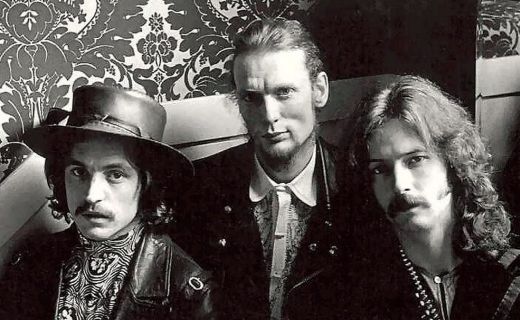This day in 1966: Jack Bruce, Ginger Baker and Eric Clapton formed Cream. The three piece group only lasted two years, leaving behind some classic recordings including ‘Sunshine of Your Love,’ ‘Badge,’ ‘Strange Brew,’ and ‘White Room.’
By July 1966, Eric Clapton’s career with the Yardbirds and John Mayall & the Bluesbreakers had earned him a reputation as the premier blues guitarist in Britain. Clapton, however, found the environment of Mayall’s band confining, and sought to expand his playing in a new band. In 1966, Clapton met Ginger Baker, then the leader of the Graham Bond Organisation, which at one point featured Jack Bruce on bass guitar, harmonica and piano. Baker felt stifled in the Graham Bond Organisation and had grown tired of Graham Bond’s drug addictions and bouts of mental instability. “I had always liked Ginger”, explained Clapton. “Ginger had come to see me play with the Bluesbreakers. After the gig he drove me back to London in his Rover. I was very impressed with his car and driving. He was telling me that he wanted to start a band, and I had been thinking about it too.”
Each was impressed with the other’s playing abilities, prompting Baker to ask Clapton to join his new, then-unnamed group. Clapton immediately agreed, on the condition that Baker hire Bruce as the group’s bassist; according to Clapton, Baker was so surprised at the suggestion that he almost crashed the car. Clapton had met Bruce when the bassist/vocalist briefly played with the Bluesbreakers in November 1965; the two also had recorded together as part of an ad hoc group dubbed Powerhouse (which also included Steve Winwood and Paul Jones). Impressed with Bruce’s vocals and technical prowess, Clapton wanted to work with him on an ongoing basis.
In contrast, while Bruce was in Bond’s band, he and Baker had been notorious for their quarrelling. Their volatile relationship included on-stage fights and the sabotage of one another’s instruments. After Baker fired Bruce from the band, Bruce continued to arrive for gigs; ultimately, Bruce was driven away from the band after Baker threatened him at knifepoint.
Baker and Bruce tried to put aside their differences for the good of Baker’s new trio, which he envisioned as collaborative, with each of the members contributing to music and lyrics. The band was named “Cream”, as Clapton, Bruce, and Baker were already considered the “cream of the crop” amongst blues and jazz musicians in the exploding British music scene. Initially, the group were referred to and billed as “The Cream”, but starting officially with its first record releases, the trio came to be known as “Cream”. Before deciding upon “Cream”, the band considered calling themselves “Sweet ‘n’ Sour Rock ‘n’ Roll”. Of the trio, Clapton had the biggest reputation in England; however, he was all but unknown in the United States, having left the Yardbirds before “For Your Love” hit the American Top Ten.
The band made its unofficial debut at the Twisted Wheel on 29 July 1966. Its official debut came two nights later at the Sixth Annual Windsor Jazz & Blues Festival. Being new and with few original songs to its credit, they performed blues reworkings that thrilled the large crowd and earned it a warm reception. In October the band also got a chance to jam with Jimi Hendrix, who had recently arrived in London. Hendrix was a fan of Clapton’s music, and wanted a chance to play with him onstage.
The band made a significant impact on the popular music of the time, and, along with Jimi Hendrix and other notable guitarists and bands, popularised the use of the wah-wah pedal. They provided a heavy yet technically proficient musical theme that foreshadowed and influenced the emergence of British bands such as Led Zeppelin, Deep Purple and Black Sabbath in the late 1960s and the early 1970s. They also influenced American southern rock groups the Allman Brothers Band and Lynyrd Skynyrd. The band’s live performances influenced progressive rock acts such as Rush.
Cream were inducted into the Rock and Roll Hall of Fame in 1993. They were included in both Rolling Stone and VH1’s lists of the “100 Greatest Artists of All Time”, at number 67 and 61 respectively. They were also ranked number 16 on VH1’s “100 Greatest Artists of Hard Rock”.




